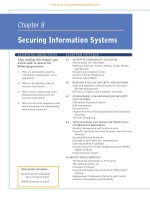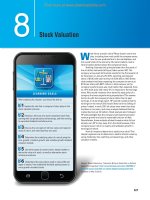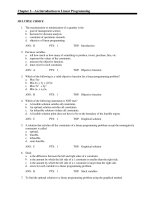Ebook An introduction to management science - Quantitative approaches to decision making (13th edition): Part 1
Bạn đang xem bản rút gọn của tài liệu. Xem và tải ngay bản đầy đủ của tài liệu tại đây (5.63 MB, 533 trang )
Copyright 2010 Cengage Learning. All Rights Reserved. May not be copied, scanned, or duplicated, in whole or in part. Due to electronic rights, some third party content may be suppressed from the eBook and/or eChapter(s).
Editorial review has deemed that any suppressed content does not materially affect the overall learning experience. Cengage Learning reserves the right to remove additional content at any time if subsequent rights restrictions require it.
R E V I S E D
T H I R T E E N T H
E D I T I O N
AN INTRODUCTION TO
MANAGEMENT
SCIENCE
QUANTITATIVE APPROACHES
TO DECISION MAKING
This page intentionally left blank
R E V I S E D
T H I R T E E N T H
E D I T I O N
AN INTRODUCTION TO
MANAGEMENT
SCIENCE
QUANTITATIVE APPROACHES
TO DECISION MAKING
David R. Anderson
University of Cincinnati
Dennis J. Sweeney
University of Cincinnati
Thomas A. Williams
Rochester Institute of Technology
Jeffrey D. Camm
University of Cincinnati
Kipp Martin
University of Chicago
Australia • Brazil • Japan • Korea • Mexico • Singapore • Spain • United Kingdom • United States
This is an electronic version of the print textbook. Due to electronic rights restrictions,
some third party content may be suppressed. Editorial review has deemed that any suppressed
content does not materially affect the overall learning experience. The publisher reserves the right
to remove content from this title at any time if subsequent rights restrictions require it. For
valuable information on pricing, previous editions, changes to current editions, and alternate
formats, please visit www.cengage.com/highered to search by ISBN#, author, title, or keyword for
materials in your areas of interest.
An Introduction to Management Science:
Quantitative Approaches to Decision
Making, Revised Thirteenth Edition
David R. Anderson, Dennis J. Sweeney,
Thomas A. Williams, Jeffrey D. Camm, &
Kipp Martin
VP/Editorial Director:
Jack W. Calhoun
Publisher:
Joe Sabatino
Senior Acquisitions Editor:
Charles McCormick, Jr.
Developmental Editor:
Maggie Kubale
Editorial Assistant:
Courtney Bavaro
Marketing Communications Manager:
Libby Shipp
Marketing Manager:
Adam Marsh
Content Project Manager:
Jacquelyn K Featherly
Media Editor:
Chris Valentine
Manufacturing Coordinator:
Miranda Klapper
Production House/Compositor:
MPS Limited, a Macmillan Company
Senior Art Director:
Stacy Jenkins Shirley
Internal Designer:
Michael Stratton/Chris Miller Design
Cover Designer:
Craig Ramsdell
Cover Images:
© Getty Images/GlowImages
Printed in the United States of America
1 2 3 4 5 6 7 14 13 12 11 10
© 2012 South-Western, a part of Cengage Learning
ALL RIGHTS RESERVED. No part of this work covered by the copyright
herein may be reproduced, transmitted, stored or used in any form or by
any means graphic, electronic, or mechanical, including but not limited
to photocopying, recording, scanning, digitizing, taping, Web
distribution, information networks, or information storage and retrieval
systems, except as permitted under Section 107 or 108 of the 1976
United States Copyright Act, without the prior written permission of
the publisher.
For product information and technology assistance, contact us at
Cengage Learning Customer & Sales Support, 1-800-354-9706
For permission to use material from this text or product,
submit all requests online at www.cengage.com/permissions
Further permissions questions can be emailed to
ExamView® and ExamView Pro® are registered trademarks of
FSCreations, Inc. Windows is a registered trademark of the Microsoft
Corporation used herein under license. Macintosh and Power
Macintosh are registered trademarks of Apple Computer, Inc. used
herein under license.
Library of Congress Control Number: 2010935955
Student Edition ISBN 13: 978-1-111-53224-6
Student Edition ISBN 10: 1-111-53224-9
Package Student Edition ISBN 13: 978-1-111-53222-2
Package Student Edition ISBN 10: 1-111-53222-2
South-Western Cengage Learning
5191 Natorp Boulevard
Mason, OH 45040
USA
Cengage Learning products are represented in Canada by
Nelson Education, Ltd.
For your course and learning solutions, visit www.cengage.com
Purchase any of our products at your local college store or at our
preferred online store www.cengagebrain.com
This page intentionally left blank
Dedication
To My Parents
Ray and Ilene Anderson
DRA
To My Parents
James and Gladys Sweeney
DJS
To My Parents
Phil and Ann Williams
TAW
To My Wife
Karen Camm
JDC
To My Wife
Gail Honda
KM
This page intentionally left blank
Brief Contents
Preface xxv
About the Authors xxix
Chapter 1
Introduction 1
Chapter 2
An Introduction to Linear Programming 28
Chapter 3
Linear Programming: Sensitivity Analysis and
Interpretation of Solution 92
Chapter 4
Linear Programming Applications in Marketing,
Finance, and Operations Management 153
Chapter 5
Advanced Linear Programming Applications 214
Chapter 6
Distribution and Network Models 255
Chapter 7
Integer Linear Programming 317
Chapter 8
Nonlinear Optimization Models 365
Chapter 9
Project Scheduling: PERT/CPM 412
Chapter 10
Inventory Models 453
Chapter 11
Waiting Line Models 502
Chapter 12
Simulation 542
Chapter 13
Decision Analysis 602
Chapter 14
Multicriteria Decisions 659
Chapter 15
Time Series Analysis and Forecasting 703
Chapter 16
Markov Processes 761
Chapter 17
Linear Programming: Simplex Method On Website
Chapter 18
Simplex-Based Sensitivity Analysis and Duality
On Website
Chapter 19
Solution Procedures for Transportation and
Assignment Problems On Website
Chapter 20
Minimal Spanning Tree On Website
Chapter 21
Dynamic Programming On Website
Appendixes 787
Appendix A Building Spreadsheet Models 788
Appendix B Areas for the Standard Normal Distribution 815
Appendix C Values of e؊λ 817
Appendix D References and Bibliography 818
Appendix E Self-Test Solutions and Answers
to Even-Numbered Problems 820
Index 853
This page intentionally left blank
Contents
Preface xxv
About the Authors xxix
Chapter 1
Introduction 1
1.1 Problem Solving and Decision Making 3
1.2 Quantitative Analysis and Decision Making 4
1.3 Quantitative Analysis 6
Model Development 7
Data Preparation 10
Model Solution 11
Report Generation 12
A Note Regarding Implementation 12
1.4 Models of Cost, Revenue, and Profit 14
Cost and Volume Models 14
Revenue and Volume Models 15
Profit and Volume Models 15
Breakeven Analysis 16
1.5 Management Science Techniques 16
Methods Used Most Frequently 18
Summary 19
Glossary 19
Problems 20
Case Problem Scheduling a Golf League 23
Appendix 1.1 Using Excel for Breakeven Analysis 24
Chapter 2
An Introduction to Linear Programming 28
2.1 A Simple Maximization Problem 30
Problem Formulation 31
Mathematical Statement of the Par, Inc., Problem 33
2.2 Graphical Solution Procedure 35
A Note on Graphing Lines 44
Summary of the Graphical Solution Procedure
for Maximization Problems 46
Slack Variables 47
2.3 Extreme Points and the Optimal Solution 48
2.4 Computer Solution of the Par, Inc., Problem 50
Interpretation of Computer Output 51
xii
Contents
2.5 A Simple Minimization Problem 52
Summary of the Graphical Solution Procedure
for Minimization Problems 54
Surplus Variables 55
Computer Solution of the M&D Chemicals Problem 56
2.6 Special Cases 57
Alternative Optimal Solutions 57
Infeasibility 58
Unbounded 60
2.7 General Linear Programming Notation 62
Summary 64
Glossary 65
Problems 66
Case Problem 1 Workload Balancing 82
Case Problem 2 Production Strategy 83
Case Problem 3 Hart Venture Capital 84
Appendix 2.1 Solving Linear Programs with LINGO 85
Appendix 2.2 Solving Linear Programs with Excel 87
Chapter 3
Linear Programming: Sensitivity Analysis
and Interpretation of Solution 92
3.1 Introduction to Sensitivity Analysis 94
3.2 Graphical Sensitivity Analysis 95
Objective Function Coefficients 95
Right-Hand Sides 100
3.3 Sensitivity Analysis: Computer Solution 103
Interpretation of Computer Output 103
Cautionary Note on the Interpretation of Dual Values 106
The Modified Par, Inc., Problem 106
3.4 Limitations of Classical Sensitivity Analysis 110
Simultaneous Changes 111
Changes in Constraint Coefficients 112
Nonintuitive Dual Values 112
3.5 The Electronic Communications Problem 116
Problem Formulation 117
Computer Solution and Interpretation 118
Summary 122
Glossary 123
Problems 123
Case Problem 1 Product Mix 145
Case Problem 2 Investment Strategy 146
Case Problem 3 Truck Leasing Strategy 147
Appendix 3.1 Sensitivity Analysis with Excel 148
Appendix 3.2 Sensitivity Analysis with LINGO 150
xiii
Contents
Chapter 4
Linear Programming Applications in
Marketing, Finance, and Operations
Management 153
4.1 Marketing Applications 154
Media Selection 155
Marketing Research 158
4.2 Financial Applications 161
Portfolio Selection 161
Financial Planning 164
4.3 Operations Management Applications 168
A Make-or-Buy Decision 168
Production Scheduling 172
Workforce Assignment 179
Blending Problems 183
Summary 188
Problems 189
Case Problem 1 Planning an Advertising Campaign 202
Case Problem 2 Phoenix Computer 203
Case Problem 3 Textile Mill Scheduling 204
Case Problem 4 Workforce Scheduling 205
Case Problem 5 Duke Energy Coal Allocation 207
Appendix 4.1 Excel Solution of Hewlitt Corporation Financial
Planning Problem 210
Chapter 5
Advanced Linear Programming
Applications 214
5.1 Data Envelopment Analysis 215
Evaluating the Performance of Hospitals 216
Overview of the DEA Approach 216
DEA Linear Programming Model 217
Summary of the DEA Approach 222
5.2 Revenue Management 223
5.3 Portfolio Models and Asset Allocation 229
A Portfolio of Mutual Funds 229
Conservative Portfolio 230
Moderate Risk Portfolio 232
5.4 Game Theory 236
Competing for Market Share 236
Identifying a Pure Strategy Solution 238
Identifying a Mixed Strategy Solution 239
Summary 247
Glossary 247
Problems 248
xiv
Contents
Chapter 6
Distribution and Network Models 255
6.1 Transportation Problem 256
Problem Variations 260
A General Linear Programming Model 262
6.2 Assignment Problem 263
Problem Variations 266
A General Linear Programming Model 267
6.3 Transshipment Problem 268
Problem Variations 274
A General Linear Programming Model 274
6.4 Shortest-Route Problem 276
A General Linear Programming Model 279
6.5 Maximal Flow Problem 279
6.6 A Production and Inventory Application 283
Summary 286
Glossary 287
Problems 288
Case Problem 1 Solutions Plus 305
Case Problem 2 Distribution System Design 306
Appendix 6.1 Excel Solution of Transportation, Assignment,
and Transshipment Problems 308
Chapter 7
Integer Linear Programming 317
7.1 Types of Integer Linear Programming Models 319
7.2 Graphical and Computer Solutions for an All-Integer
Linear Program 321
Graphical Solution of the LP Relaxation 322
Rounding to Obtain an Integer Solution 322
Graphical Solution of the All-Integer Problem 323
Using the LP Relaxation to Establish Bounds 323
Computer Solution 324
7.3 Applications Involving 0-1 Variables 325
Capital Budgeting 325
Fixed Cost 326
Distribution System Design 329
Bank Location 334
Product Design and Market Share Optimization 337
7.4 Modeling Flexibility Provided by 0-1 Integer Variables 341
Multiple-Choice and Mutually Exclusive Constraints 341
k out of n Alternatives Constraint 342
Conditional and Corequisite Constraints 342
A Cautionary Note About Sensitivity Analysis 344
xv
Contents
Summary 344
Glossary 345
Problems 346
Case Problem 1 Textbook Publishing 357
Case Problem 2 Yeager National Bank 358
Case Problem 3 Production Scheduling with Changeover Costs 359
Appendix 7.1 Excel Solution of Integer Linear Programs 360
Appendix 7.2 LINGO Solution of Integer Linear Programs 361
Chapter 8
Nonlinear Optimization Models 365
8.1 A Production Application—Par, Inc., Revisited 367
An Unconstrained Problem 367
A Constrained Problem 368
Local and Global Optima 371
Dual Values 374
8.2 Constructing an Index Fund 374
8.3 Markowitz Portfolio Model 379
8.4 Blending: The Pooling Problem 382
8.5 Forecasting Adoption of a New Product 387
Summary 392
Glossary 392
Problems 393
Case Problem 1 Portfolio Optimization with Transaction
Costs 402
Case Problem 2 CAFE Compliance in the Auto Industry 405
Appendix 8.1 Solving Nonlinear Problems with LINGO 408
Appendix 8.2 Solving Nonlinear Problems with Excel Solver 409
Chapter 9
Project Scheduling: PERT/CPM 412
9.1 Project Scheduling with Known Activity Times 413
The Concept of a Critical Path 414
Determining the Critical Path 416
Contributions of PERT/CPM 420
Summary of the PERT/CPM Critical Path Procedure 421
9.2 Project Scheduling with Uncertain Activity Times 422
The Daugherty Porta-Vac Project 423
Uncertain Activity Times 423
The Critical Path 425
Variability in Project Completion Time 428
9.3 Considering Time-Cost Trade-Offs 431
Crashing Activity Times 432
Linear Programming Model for Crashing 434
xvi
Contents
Summary 436
Glossary 437
Problems 438
Case Problem R. C. Coleman 448
Appendix 9.1 Using Microsoft Office Project 450
Chapter 10
Inventory Models 453
10.1 Economic Order Quantity (EOQ) Model 454
The How-Much-to-Order Decision 459
The When-to-Order Decision 460
Sensitivity Analysis for the EOQ Model 461
Excel Solution of the EOQ Model 462
Summary of the EOQ Model Assumptions 463
10.2 Economic Production Lot Size Model 464
Total Cost Model 465
Economic Production Lot Size 467
10.3 Inventory Model with Planned Shortages 467
10.4 Quantity Discounts for the EOQ Model 472
10.5 Single-Period Inventory Model with Probabilistic Demand 474
Johnson Shoe Company 475
Nationwide Car Rental 479
10.6 Order-Quantity, Reorder Point Model with Probabilistic
Demand 480
The How-Much-to-Order Decision 481
The When-to-Order Decision 482
10.7 Periodic Review Model with Probabilistic Demand 484
More Complex Periodic Review Models 487
Summary 488
Glossary 489
Problems 491
Case Problem 1 Wagner Fabricating Company 498
Case Problem 2 River City Fire Department 499
Appendix 10.1 Development of the Optimal Order Quantity (Q*)
Formula for the EOQ Model 500
Appendix 10.2 Development of the Optimal Lot Size (Q*) Formula
for the Production Lot Size Model 501
Chapter 11
Waiting Line Models 502
11.1 Structure of a Waiting Line System 504
Single-Channel Waiting Line 504
Distribution of Arrivals 504
Distribution of Service Times 506
xvii
Contents
11.2
11.3
11.4
11.5
11.6
11.7
11.8
11.9
Queue Discipline 507
Steady-State Operation 507
Single-Channel Waiting Line Model with Poisson Arrivals
and Exponential Service Times 508
Operating Characteristics 508
Operating Characteristics for the Burger Dome Problem 509
Managers’ Use of Waiting Line Models 510
Improving the Waiting Line Operation 510
Excel Solution of Waiting Line Model 511
Multiple-Channel Waiting Line Model with Poisson Arrivals
and Exponential Service Times 512
Operating Characteristics 513
Operating Characteristics for the Burger Dome Problem 515
Some General Relationships for Waiting Line Models 517
Economic Analysis of Waiting Lines 519
Other Waiting Line Models 520
Single-Channel Waiting Line Model with Poisson Arrivals
and Arbitrary Service Times 521
Operating Characteristics for the M/G/1 Model 521
Constant Service Times 523
Multiple-Channel Model with Poisson Arrivals, Arbitrary Service
Times, and No Waiting Line 524
Operating Characteristics for the M/G/k Model with Blocked
Customers Cleared 524
Waiting Line Models with Finite Calling Populations 526
Operating Characteristics for the M/M/1 Model with a Finite
Calling Population 527
Summary 529
Glossary 531
Problems 531
Case Problem 1 Regional Airlines 539
Case Problem 2 Office Equipment, Inc. 540
Chapter 12
Simulation 542
12.1 Risk Analysis 545
PortaCom Project 545
What-If Analysis 545
Simulation 547
Simulation of the PortaCom Project 554
12.2 Inventory Simulation 558
Butler Inventory Simulation 561
12.3 Waiting Line Simulation 563
Hammondsport Savings Bank ATM Waiting Line 563
Customer Arrival Times 564
xviii
Contents
Customer Service Times 565
Simulation Model 565
Hammondsport Savings Bank ATM Simulation 569
Simulation with Two ATMs 570
Simulation Results with Two ATMs 572
12.4 Other Simulation Issues 574
Computer Implementation 574
Verification and Validation 575
Advantages and Disadvantages of Using Simulation 575
Summary 576
Glossary 577
Problems 578
Case Problem 1 Tri-State Corporation 585
Case Problem 2 Harbor Dunes Golf Course 587
Case Problem 3 County Beverage Drive-Thru 589
Appendix 12.1 Simulation with Excel 590
Appendix 12.2 Simulation Using Crystal Ball 597
Chapter 13
Decision Analysis 602
13.1 Problem Formulation 604
Influence Diagrams 605
Payoff Tables 605
Decision Trees 606
13.2 Decision Making Without Probabilities 607
Optimistic Approach 607
Conservative Approach 607
Minimax Regret Approach 608
13.3 Decision Making with Probabilities 610
Expected Value of Perfect Information 613
13.4 Risk Analysis and Sensitivity Analysis 615
Risk Analysis 615
Sensitivity Analysis 616
13.5 Decision Analysis with Sample Information 620
Influence Diagram 620
Decision Tree 621
Decision Strategy 623
Risk Profile 627
Expected Value of Sample Information 629
Efficiency of Sample Information 630
13.6 Computing Branch Probabilities 630
Summary 634
Glossary 635
Problems 637
Case Problem 1 Property Purchase Strategy 651
xix
Contents
Case Problem 2 Lawsuit Defense Strategy 652
Appendix 13.1 Decision Analysis with Treeplan 653
Chapter 14
Multicriteria Decisions 659
14.1 Goal Programming: Formulation and Graphical Solution 660
Developing the Constraints and the Goal Equations 661
Developing an Objective Function with Preemptive Priorities 663
Graphical Solution Procedure 664
Goal Programming Model 667
14.2 Goal Programming: Solving More Complex Problems 668
Suncoast Office Supplies Problem 668
Formulating the Goal Equations 669
Formulating the Objective Function 670
Computer Solution 671
14.3 Scoring Models 674
14.4 Analytic Hierarchy Process 679
Developing the Hierarchy 680
14.5 Establishing Priorities Using AHP 680
Pairwise Comparisons 681
Pairwise Comparison Matrix 682
Synthesization 684
Consistency 685
Other Pairwise Comparisons for the Car Selection Problem 687
14.6 Using AHP to Develop an Overall Priority Ranking 688
Summary 690
Glossary 690
Problems 691
Case Problem EZ Trailers, Inc. 700
Appendix 14.1 Scoring Models with Excel 701
Chapter 15
Time Series Analysis and Forecasting 703
15.1 Time Series Patterns 705
Horizontal Pattern 705
Trend Pattern 707
Seasonal Pattern 709
Trend and Seasonal Pattern 710
Cyclical Pattern 713
Selecting a Forecasting Method 713
15.2 Forecast Accuracy 713
15.3 Moving Averages and Exponential Smoothing 717
Moving Averages 717
Weighted Moving Averages 720
Exponential Smoothing 721
xx
Contents
15.4 Trend Projection 726
Linear Trend 726
Nonlinear Trend 730
15.5 Seasonality 733
Seasonality Without Trend 734
Seasonality and Trend 737
Models Based on Monthly Data 739
Summary 740
Glossary 741
Problems 741
Case Problem 1 Forecasting Food and Beverage Sales 751
Case Problem 2 Forecasting Lost Sales 751
Appendix 15.1 Forecasting with Excel Data Analysis Tools 753
Appendix 15.2 Forecasting with Excel Solver 754
Appendix 15.3 Forecasting with LINGO 759
Chapter 16
Markov Processes 761
16.1 Market Share Analysis 763
16.2 Accounts Receivable Analysis 771
Fundamental Matrix and Associated Calculations 772
Establishing the Allowance for Doubtful Accounts 774
Summary 776
Glossary 776
Problems 777
Case Problem Dealer’s Absorbing State Probabilities in Blackjack 781
Appendix 16.1 Matrix Notation and Operations 782
Appendix 16.2 Matrix Inversion with Excel 785
Chapter 17
Linear Programming: Simplex Method On Website
17.1 An Algebraic Overview of the Simplex Method 17-2
Algebraic Properties of the Simplex Method 17-3
Determining a Basic Solution 17-3
Basic Feasible Solution 17-4
17.2 Tableau Form 17-5
17.3 Setting up the Initial Simplex Tableau 17-7
17.4 Improving the Solution 17-10
17.5 Calculating the Next Tableau 17-12
Interpreting the Results of an Iteration 17-15
Moving Toward a Better Solution 17-15
Interpreting the Optimal Solution 17-18
Summary of the Simplex Method 17-19
xxi
Contents
17.6 Tableau Form: The General Case 17-20
Greater-Than-or-Equal-to Constraints 17-20
Equality Constraints 17-24
Eliminating Negative Right-Hand-Side Values 17-25
Summary of the Steps to Create Tableau Form 17-26
17.7 Solving a Minimization Problem 17-27
17.8 Special Cases 17-29
Infeasibility 17-29
Unboundedness 17-31
Alternative Optimal Solutions 17-32
Degeneracy 17-33
Summary 17-35
Glossary 17-36
Problems 17-37
Chapter 18
Simplex-Based Sensitivity Analysis and Duality
On Website
18.1 Sensitivity Analysis with the Simplex Tableau 18-2
Objective Function Coefficients 18-2
Right-Hand-Side Values 18-6
Simultaneous Changes 18-13
18.2 Duality 18-14
Economic Interpretation of the Dual Variables 18-16
Using the Dual to Identify the Primal Solution 18-18
Finding the Dual of Any Primal Problem 18-18
Summary 18-20
Glossary 18-21
Problems 18-21
Chapter 19
Solution Procedures for Transportation
and Assignment Problems On Website
19.1 Transportation Simplex Method: A Special-Purpose Solution
Procedure 19-2
Phase I: Finding an Initial Feasible Solution 19-2
Phase II: Iterating to the Optimal Solution 19-7
Summary of the Transportation Simplex Method 19-17
Problem Variations 19-17
19.2 Assignment Problem: A Special-Purpose Solution Procedure 19-18
Finding the Minimum Number of Lines 19-21
Problem Variations 19-21
Glossary 19-25
Problems 19-26
xxii
Contents
Chapter 20
Minimal Spanning Tree On Website
A Minimal Spanning Tree Algorithm 20-2
Glossary 20-5
Problems 20-5
Chapter 21
21.1
21.2
21.3
21.4
Dynamic Programming On Website
A Shortest-Route Problem 21-2
Dynamic Programming Notation 21-6
The Knapsack Problem 21-10
A Production and Inventory Control Problem 21-16
Summary 21-20
Glossary 21-21
Problems 21-22
Case Problem Process Design 21-26
Appendixes 787
Appendix A
Appendix B
Appendix C
Appendix D
Appendix E
Index 853
Building Spreadsheet Models 788
Areas for the Standard Normal Distribution 815
Values of e؊λ 817
References and Bibliography 818
Self-Test Solutions and Answers
to Even-Numbered Problems 820









